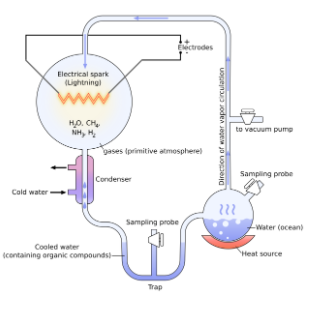
Explain the miller's experiment with the help of diagrams?
Answer
573.9k+ views
Hint:
In this experiment Miller created exactly the same conditions at the laboratory level as predicted on proto-Earth. He observed the formation of simple amino acids such as glycine, alanine and aspartic acid.
Complete answer:
In this question we have asked to explain Miller's experiment. As we already mentioned In 1953, American scientist S.L. Miller created exactly the same conditions at the laboratory level as predicted on proto-Earth. In his experiment, he observed the formation of simple amino acids such as glycine, alanine and aspartic acid. Through his experiment, he presented evidence in favour of organic compounds forming the basis of evolution.

He conducted an experiment to understand the origin of life. We can see in this diagram that Miller took molecules that were the major components of the early earth. He put them into sterile glass tubes and flasks connected together in a loop and circulated inside the apparatus. These gases were methane, ammonia, hydrogen, and water. When he passed an electric current through the system, which was similar to lightning storms which was common on early earth. In 7 to 8 day he saw that some methane and other molecules changed into organic compounds like protein and carbon. So, this experiment proves that organic compounds, which are required for cellular life, were made spontaneously from those gases under the conditions believed to be present on the early earth.
Note: In Miller's experiment he synthesized glycine, aspartic acid and alanine in abundance quantities while glutamic acid is not synthesized in their experiment.
In this experiment Miller created exactly the same conditions at the laboratory level as predicted on proto-Earth. He observed the formation of simple amino acids such as glycine, alanine and aspartic acid.
Complete answer:
In this question we have asked to explain Miller's experiment. As we already mentioned In 1953, American scientist S.L. Miller created exactly the same conditions at the laboratory level as predicted on proto-Earth. In his experiment, he observed the formation of simple amino acids such as glycine, alanine and aspartic acid. Through his experiment, he presented evidence in favour of organic compounds forming the basis of evolution.

He conducted an experiment to understand the origin of life. We can see in this diagram that Miller took molecules that were the major components of the early earth. He put them into sterile glass tubes and flasks connected together in a loop and circulated inside the apparatus. These gases were methane, ammonia, hydrogen, and water. When he passed an electric current through the system, which was similar to lightning storms which was common on early earth. In 7 to 8 day he saw that some methane and other molecules changed into organic compounds like protein and carbon. So, this experiment proves that organic compounds, which are required for cellular life, were made spontaneously from those gases under the conditions believed to be present on the early earth.
Note: In Miller's experiment he synthesized glycine, aspartic acid and alanine in abundance quantities while glutamic acid is not synthesized in their experiment.
Recently Updated Pages
A man running at a speed 5 ms is viewed in the side class 12 physics CBSE

The number of solutions in x in 02pi for which sqrt class 12 maths CBSE

State and explain Hardy Weinbergs Principle class 12 biology CBSE

Write any two methods of preparation of phenol Give class 12 chemistry CBSE

Which of the following statements is wrong a Amnion class 12 biology CBSE

Differentiate between action potential and resting class 12 biology CBSE

Trending doubts
What are the major means of transport Explain each class 12 social science CBSE

Which are the Top 10 Largest Countries of the World?

Draw a labelled sketch of the human eye class 12 physics CBSE

Explain sex determination in humans with line diag class 12 biology CBSE

Explain sex determination in humans with the help of class 12 biology CBSE

Differentiate between homogeneous and heterogeneous class 12 chemistry CBSE




